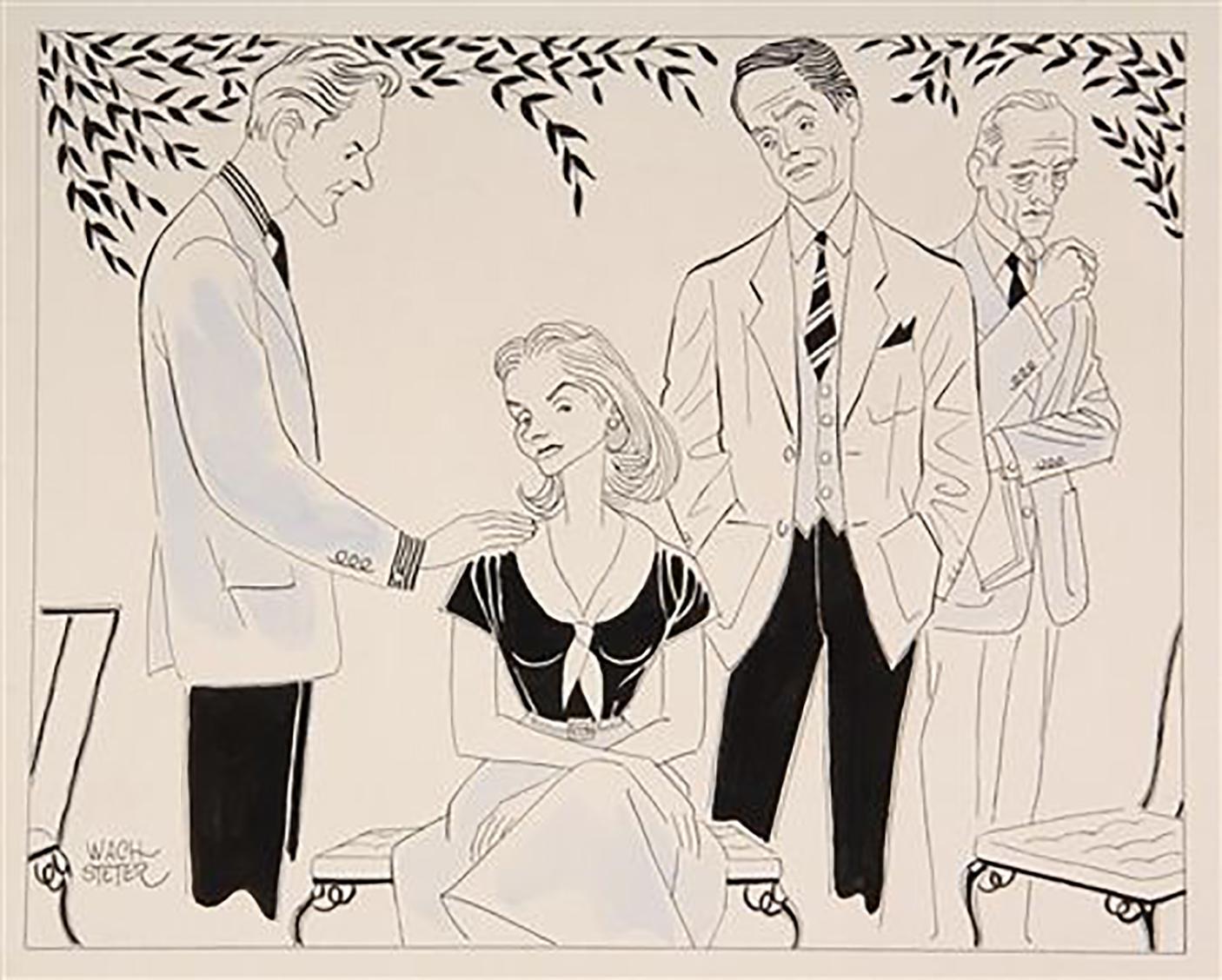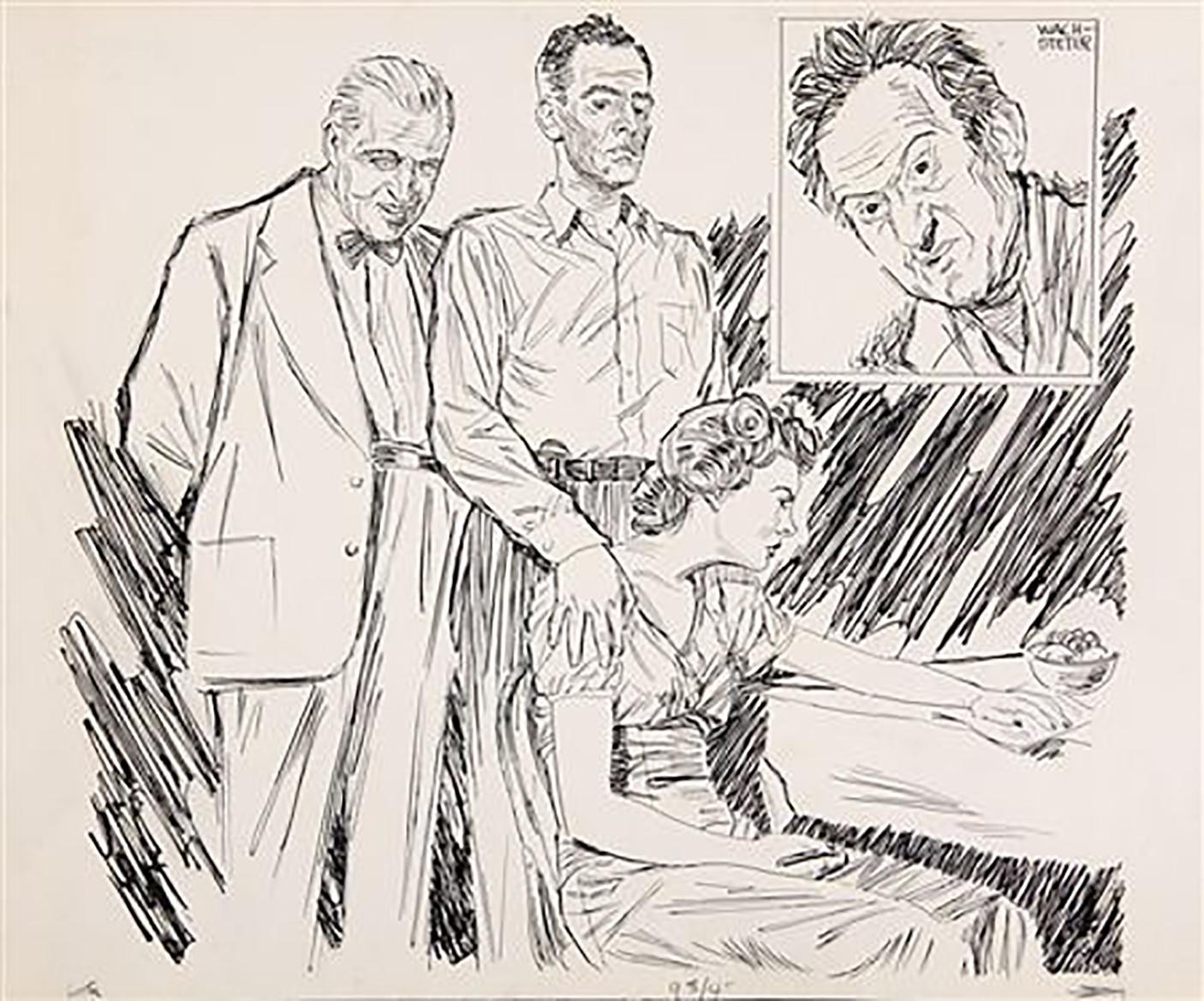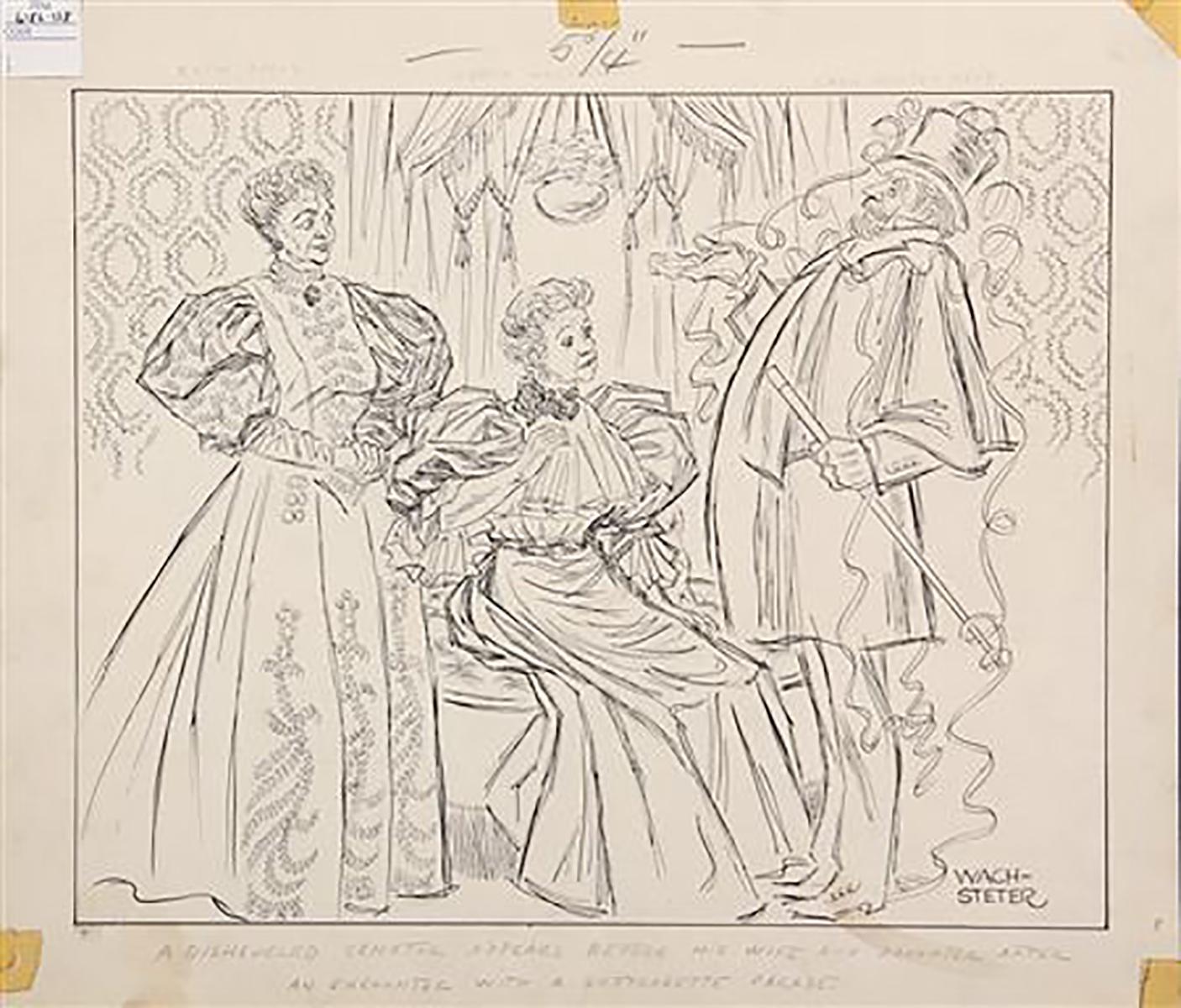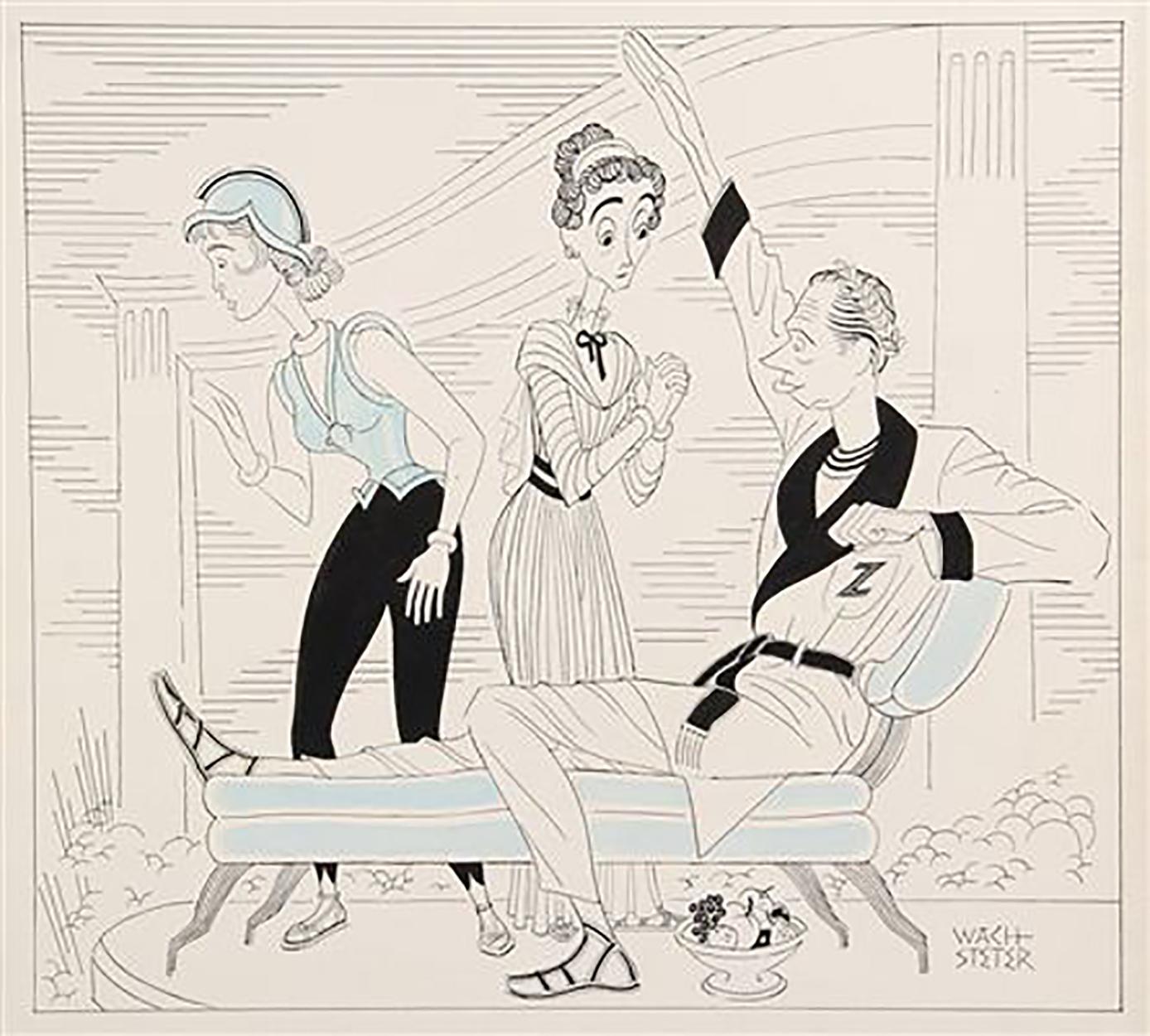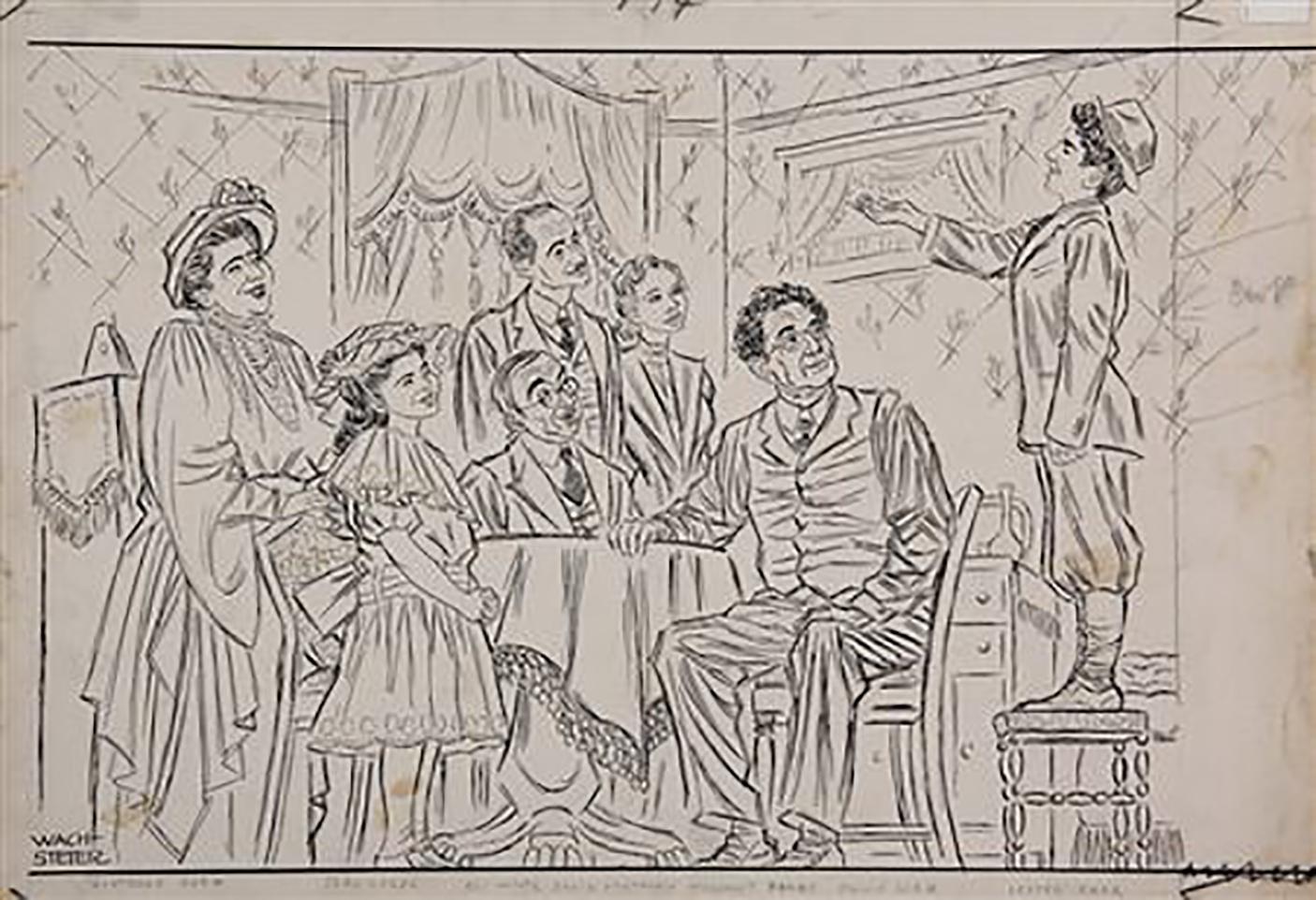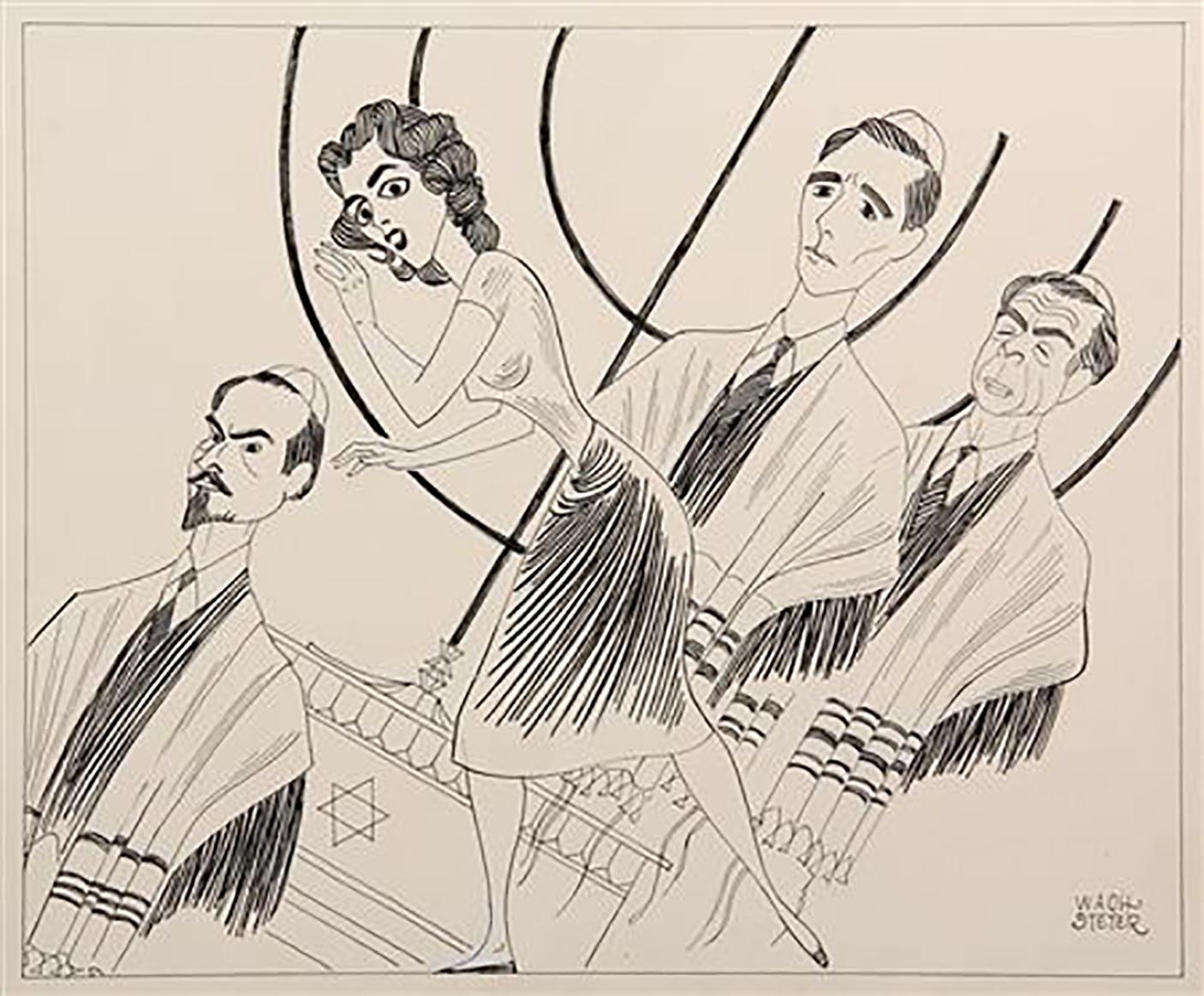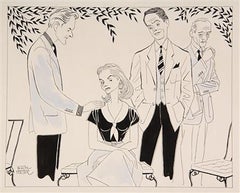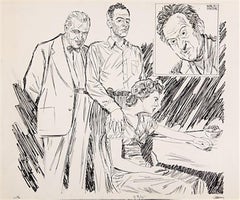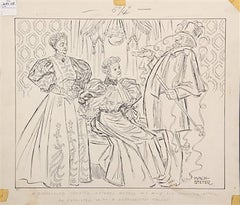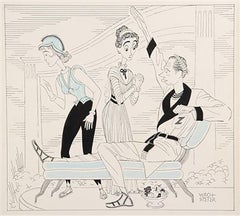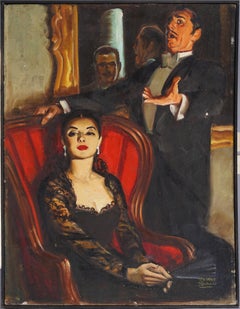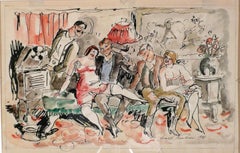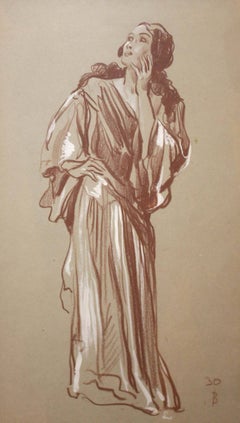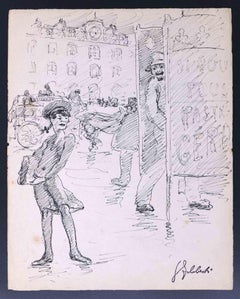Items Similar to The Broadway Cast of "Kathleen"
Want more images or videos?
Request additional images or videos from the seller
1 of 5
George WachsteterThe Broadway Cast of "Kathleen"1948
1948
$500
£387.69
€439.69
CA$716.73
A$779.46
CHF 410.64
MX$9,466.67
NOK 5,162.53
SEK 4,839.45
DKK 3,301.08
About the Item
Medium: Pen and Ink on Illustration Board
Signature: Signed Upper Right
Drawing by George Wachsteter (1911-2004), Broadway cast of `Kathleen` by Michael Sayers, staged by Coby Ruskin and performed at the Mansfield Theatre from Feb. 3 to10, 1948. From left to right: Whitfield Connor as Lt. Aengus McOgue (erroneously identified as "Whitford Connor" confusing first name with actor Whitford Kane who portrayed Father Keogh in the play but is not shown); James McCallion as Christy Hanafey; Henry Jones as Seamus MacGonigal; Morton L. Stevens as Jamie MacGonigal; Andree Wallace as Kathleen Fogarty; Jack Sheehan as Prof. Jasper Fogarty; Frank Merlin as Dr. Horatio Houlihan (seated); and Anita Bolster as Lily the Housekeeper.
This piece is on 15.00" x 20.00" illustration board, the drawing itself measures to 11.00" x 17.00." The piece was used for the New York Herald Tribune. Includes clipping. Good condition.
- Creator:George Wachsteter (1911 - 2004)
- Creation Year:1948
- Dimensions:Height: 11 in (27.94 cm)Width: 17 in (43.18 cm)
- Medium:
- Period:
- Condition:
- Gallery Location:Fort Washington, PA
- Reference Number:Seller: 23591stDibs: LU38436193842
About the Seller
5.0
Recognized Seller
These prestigious sellers are industry leaders and represent the highest echelon for item quality and design.
Established in 1995
1stDibs seller since 2016
139 sales on 1stDibs
Typical response time: 1 hour
- ShippingRetrieving quote...Shipping from: Fort Washington, PA
- Return Policy
Authenticity Guarantee
In the unlikely event there’s an issue with an item’s authenticity, contact us within 1 year for a full refund. DetailsMoney-Back Guarantee
If your item is not as described, is damaged in transit, or does not arrive, contact us within 7 days for a full refund. Details24-Hour Cancellation
You have a 24-hour grace period in which to reconsider your purchase, with no questions asked.Vetted Professional Sellers
Our world-class sellers must adhere to strict standards for service and quality, maintaining the integrity of our listings.Price-Match Guarantee
If you find that a seller listed the same item for a lower price elsewhere, we’ll match it.Trusted Global Delivery
Our best-in-class carrier network provides specialized shipping options worldwide, including custom delivery.More From This Seller
View AllBroadway Comedy, "Four Winds"
By George Wachsteter
Located in Fort Washington, PA
Medium: Pen and Ink on Illustration Board
Signature: Signed Lower Left
On 15.00" x 20.00" illustration board with a 11.00" x 13.75" image. Mediums include blue indicating halftone. The illustration was commissioned for the New York Journal-American, clipping included.
Caricature by George Wachsteter (1911-2004) for Broadway Comedy `Four Winds...
Category
1950s Figurative Drawings and Watercolors
Materials
Ink, Illustration Board, Pen
Broadway Production of Sartre's "The Respectful Prostitute"
By George Wachsteter
Located in Fort Washington, PA
Medium: Pen and Ink on Cardstock
Signature: Signed Upper Right
The piece is on 14.00" x 22.50" cardstock, with an image that measures to 13.50" x 15.00."
Includes clipping.
Drawing...
Category
1940s Figurative Drawings and Watercolors
Materials
Ink, Pen
Broadway Production of "Strange Bedfellows"
By George Wachsteter
Located in Fort Washington, PA
Medium: Pen and Ink on Cardstock
Signature: Signed Lower Right
Caricature by George Wachsteter (1911-2004) for 1948 Broadway production `Strange Bedfellows` with Ruth Amos, Nydia We...
Category
1940s Figurative Drawings and Watercolors
Materials
Ink, Pen
Broadway Production of Paul Osborne's "Maiden Voyage"
By George Wachsteter
Located in Fort Washington, PA
Medium: Pen and Ink on Illustration Board
Signature: Signed Lower Right
Caricature by George Wachsteter (1911-2004) for would-be Broadway production of Paul Osborne`s `Maiden Voyage...
Category
1950s Figurative Drawings and Watercolors
Materials
Ink, Illustration Board, Pen
1948 Broadway Show "Me and Molly"
By George Wachsteter
Located in Fort Washington, PA
Medium: Pen and Ink on Illustration Board
Signature: Signed Lower Left
Drawing by George Wachsteter (1911-2004) for 1948 Broadway show `Me and Molly` by Gertrude Berg, based on her radio show `The Goldbergs`, but set in the year 1919. Berg appears first on left. The other actors (l to r) are Joan Lazer as daughter Rosalie, Eli Mintz as Uncle David (also on radio & TV), David Opatoshu as Mr. Mendel, Margaret Feury as Vera, Philip Loeb as husband Jake (also on radio & TV) & Lester Carr as son Sammy. Directed by Ezra Stone, designed by Harry Horner...
Category
1940s Figurative Drawings and Watercolors
Materials
Ink, Illustration Board, Pen
Broadway Play, "The Tenth Man"
By George Wachsteter
Located in Fort Washington, PA
Medium: Pen and Ink on Cardstock
Signature: Signed Lower Right
Caricature by George Wachsteter (1911-2004), for the Broadway play `The Tenth Man` by Em...
Category
1950s Figurative Drawings and Watercolors
Materials
Ink, Pen
You May Also Like
Antique American Opera Scene Signed Rare Illustration Framed Genre Oil Painting
Located in Buffalo, NY
Incredible early American illustration of an opera scene by Richard W. Baldwin (1920 - 2012) . Oil on canvas. Framed. Signed.
Category
1940s Impressionist Interior Paintings
Materials
Canvas, Oil
ORTHOPHONIC EVENING
By Walt Kuhn
Located in Portland, ME
Kuhn, Walt (American, 1877-1949). ORTHOPHONIC EVENING. Drawing,
ink and watercolor, 1928. Titled, signed and dated within the
image, in ink, and further inscribed with the copyright symbol (c
in a circle) and signed and dated 1937, in pencil, presumably to
preserve reproduction and publication rights. 9 1/2 x 15 1/2
inches, plus margins of about 1/2 inch. In excellent condition.
The "Orthophonic Victrola," introduced in 1925, was the first
electric record player sold commercially. In the drawing it is
seen at the left, with the host changing a record. The rest of
the drawing reveals that listening to music was not the primary
activity of the "orthophonic evening."
The following is quoted from The Pillips Collection's biography
of Kuhn:
Walt Kuhn is remembered as an early promoter of modern art in
America. He was not only a well-known painter, but also a
cartoonist, sculptor, printmaker, writer, teacher, and producer
of vaudeville shows. Born in 1877, Kuhn grew up in Brooklyn,
where he received his education in private schools until he was
sixteen. In 1899 he ventured to San Francisco to work as a
cartoonist for The Wasp, a political and literary weekly. In 1901
Kuhn traveled to Europe for formal art training at the Académie
Colarossi in Paris and later at the Munich Academy. Returning to
New York in 1903, he established a studio in Manhattan and helped
arrange the 1910 Exhibition of Independent Artists. He was a
founding member and officer of the Association of American
Painters and Sculptors, the organization responsible for mounting
the Armory Show of 1913, and in this role traveled through Europe
in 1912 looking at art and helping to select works to be
exhibited. Seeing paintings by Cézanne, Derain, Dufy, Pascin, and
the cubists affected his style, and throughout the teens and
early twenties Kuhn experimented with fauve colors, using blocks
of color akin to Cézanne and with cubist space, integrating
abstracted forms into the space of the picture plane. Finally, he
developed his own painting style characterized by solid,
sculptural depictions of single figures.
Kuhn had his first solo show in 1910 at the Madison Gallery...
Category
1920s Figurative Drawings and Watercolors
Materials
Watercolor
Theater Sketch 2
By Alexander Oscar Levy
Located in Buffalo, NY
Alexander O. Levy was a painter, illustrator,
printmaker and designer who was born in 1881 in Bonn, Germany. He
died in 1946 in Buffalo, New York. At age three, he was brought to
...
Category
1930s Art Deco Figurative Drawings and Watercolors
Materials
Archival Paper, Charcoal, Gouache
The Musical Group - Drawing by Georges Guido Filiberti - 1930s
Located in Roma, IT
The Musical Group is an Original Drawing, china ink on yellowed paper, realized by the french artist Georges Guido Filiberti. Hand signed on th...
Category
1930s Modern Figurative Drawings and Watercolors
Materials
Ink
Andrée Ruellan, Spring on Bleecker Street (Greenwich Village, NY), crayon, 1938
By Andrée Ruellan
Located in New York, NY
Spring, Bleecker Street, Ruellan's conté crayon drawing from 1938, shows young people out in the world. And their world is Bleecker Street, New York City. The heart of Greenwich Vil...
Category
1930s Ashcan School Figurative Drawings and Watercolors
Materials
Crayon
Fancy Department Store Satirical Cartoon
Located in Wilton Manors, FL
Barbara Shermund (1899-1978). Fancy Department Store Satirical Cartoon, ca. 1930's. Ink, watercolor and gouache on heavy illustration paper, panel measures 19 x 15 inches. Signed lower right. Very good condition. Unframed.
Provenance: Ethel Maud Mott Herman, artist (1883-1984), West Orange NJ.
For two decades, she drew almost 600 cartoons for The New Yorker with female characters that commented on life with wit, intelligence and irony.
In the mid-1920s, Harold Ross, the founder of a new magazine called The New Yorker, was looking for cartoonists who could create sardonic, highbrow illustrations accompanied by witty captions that would function as social critiques.
He found that talent in Barbara Shermund.
For about two decades, until the 1940s, Shermund helped Ross and his first art editor, Rea Irvin, realize their vision by contributing almost 600 cartoons and sassy captions with a fresh, feminist voice.
Her cartoons commented on life with wit, intelligence and irony, using female characters who critiqued the patriarchy and celebrated speakeasies, cafes, spunky women and leisure. They spoke directly to flapper women of the era who defied convention with a new sense of political, social and economic independence.
“Shermund’s women spoke their minds about sex, marriage and society; smoked cigarettes and drank; and poked fun at everything in an era when it was not common to see young women doing so,” Caitlin A. McGurk wrote in 2020 for the Art Students League.
In one Shermund cartoon, published in The New Yorker in 1928, two forlorn women sit and chat on couches. “Yeah,” one says, “I guess the best thing to do is to just get married and forget about love.”
“While for many, the idea of a New Yorker cartoon conjures a highbrow, dry non sequitur — often more alienating than familiar — Shermund’s cartoons are the antithesis,” wrote McGurk, who is an associate curator and assistant professor at Ohio State University’s Billy Ireland Cartoon Library & Museum. “They are about human nature, relationships, youth and age.” (McGurk is writing a book about Shermund.
And yet by the 1940s and ’50s, as America’s postwar focus shifted to domestic life, Shermund’s feminist voice and cool critique of society fell out of vogue. Her last cartoon appeared in The New Yorker in 1944, and much of her life and career after that remains unclear. No major newspaper wrote about her death in 1978 — The New York Times was on strike then, along with The Daily News and The New York Post — and her ashes sat in a New Jersey funeral home...
Category
1930s Realist Figurative Paintings
Materials
Gouache, Ink
$1,875 Sale Price
25% Off
